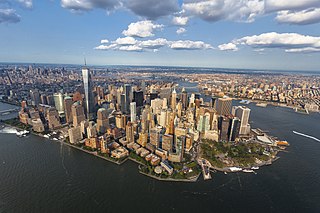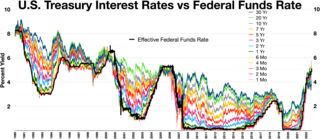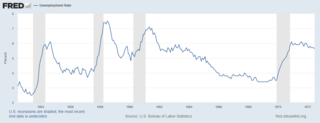Related Research Articles
In economics, a recession is a business cycle contraction that occurs when there is a general decline in economic activity. Recessions generally occur when there is a widespread drop in spending. This may be triggered by various events, such as a financial crisis, an external trade shock, an adverse supply shock, the bursting of an economic bubble, or a large-scale anthropogenic or natural disaster.

The United States is a highly developed/advanced mixed economy. It is the world's largest economy by nominal GDP; it is also the second largest by purchasing power parity (PPP), behind China. It has the world's seventh highest per capita GDP (nominal) and the eighth highest per capita GDP (PPP) as of 2022. The U.S. accounted for 25.4% of the global economy in 2022 in nominal terms, and about 15.6% in PPP terms. The U.S. dollar is the currency of record most used in international transactions and is the world's reserve currency, backed by a large U.S. treasuries market, its role as the reference standard for the petrodollar system, and its linked eurodollar. Several countries use it as their official currency and in others it is the de facto currency.
An economic depression is a period of carried long-term economic downturn that is the result of lowered economic activity in one major or more national economies. Economic depression maybe related to one specific country where there is some economic crisis that has worsened but most often reflexes historically the American Great Depression and similar economic status that may be recognized as existing at some country, several countries or even in many countries. It is often understood in economics that economic crisis and the following recession that maybe named economic depression are part of economic cycles where the slowdown of the economy follows the economic growth and vice versa. It is a result of more severe economic problems or a downturn than the recession itself, which is a slowdown in economic activity over the course of the normal business cycle of growing economy.
Business cycles are intervals of general expansion followed by recession in economic performance. The changes in economic activity that characterize business cycles have important implications for the welfare of the general population, government institutions, and private sector firms. There are numerous specific definitions of what constitutes a business cycle. The simplest and most naïve characterization comes from regarding recessions as 2 consecutive quarters of negative GDP growth. More satisfactory classifications are provided by, first including more economic indicators and second by looking for more informative data patterns than the ad hoc 2 quarter definition.
The early 1990s recession describes the period of economic downturn affecting much of the Western world in the early 1990s. The impacts of the recession contributed in part to the 1992 U.S. presidential election victory of Bill Clinton over incumbent president George H. W. Bush. The recession also included the resignation of Canadian prime minister Brian Mulroney, the reduction of active companies by 15% and unemployment up to nearly 20% in Finland, civil disturbances in the United Kingdom and the growth of discount stores in the United States and beyond.

The National Bureau of Economic Research (NBER) is an American private nonprofit research organization "committed to undertaking and disseminating unbiased economic research among public policymakers, business professionals, and the academic community." The NBER is known for proposing start and end dates for recessions in the United States.
The post–World War I recession was an economic recession that hit much of the world in the aftermath of World War I. In many nations, especially in North America, economic growth continued and even accelerated during World War I as nations mobilized their economies to fight the war in Europe. After the war ended, the global economy began to decline. In the United States, 1918–1919 saw a modest economic retreat, but the second part of 1919 saw a mild recovery. A more severe recession hit the United States in 1920 and 1921, when the global economy fell very sharply.

The early 2000s recession was a decline in economic activity which mainly occurred in developed countries. The recession affected the European Union during 2000 and 2001 and the United States from March to November 2001. The UK, Canada and Australia avoided the recession, while Russia, a nation that did not experience prosperity during the 1990s, began to recover from it. Japan's 1990s recession continued.

The C. D. Howe Institute is a Canadian nonprofit policy research organization in Toronto, Ontario, Canada. It aims to be distinguished by "research that is nonpartisan, evidence-based, and subject to definitive expert review." The institute's office is located in the Trader's Bank Building in downtown Toronto.
Stephen A. Jarislowsky, is a Canadian business magnate, investor, and philanthropist. He is the founder, chairman and CEO of Jarislowsky Fraser Limited, a Canadian investment management firm with over Can$40 billion in assets under management.

The early 1980s recession was a severe economic recession that affected much of the world between approximately the start of 1980 and 1982. It is widely considered to have been the most severe recession since World War II until the 2007–2008 financial crisis.
David Ernest William Laidler is an English/Canadian economist who has been one of the foremost scholars of monetarism. He published major economics journal articles on the topic in the late 1960s and early 1970s. His book, The Demand for Money, was published in four editions from 1969 through 1993, initially setting forth the stability of the relationship between income and the demand for money and later taking into consideration the effects of legal, technological, and institutional changes on the demand for money. The book has been translated into French, Spanish, Italian, Japanese, and Chinese.

The Great Moderation is a period in the United States of America starting from the mid-1980s until at least 2007 characterized by the reduction in the volatility of business cycle fluctuations in developed nations compared with the decades before. It is believed to be caused by institutional and structural changes, particularly in central bank policies, in the second half of the twentieth century.

A global recession is recession that affects many countries around the world—that is, a period of global economic slowdown or declining economic output.

The recession of 1960–1961 was a recession in the United States. According to the National Bureau of Economic Research, the recession lasted for 10 months, beginning in April 1960 and ending in February 1961. The recession preceded the third-longest economic expansion in U.S. history, from February 1961 until the beginning of the recession of 1969–1970 in December 1968.

The recession of 1949 was a downturn in the United States lasting for 11 months. According to the National Bureau of Economic Research, the recession began in November 1948 and lasted until October 1949.
The Economic Cycle Research Institute (ECRI) based in New York City, is an independent institute formed in 1996 by Geoffrey H. Moore, Anirvan Banerji, and Lakshman Achuthan. It provides economic modeling, financial databases, economic forecasting, and market cycles services to investment managers, business executives, and government policymakers.
References
- ↑ "Business Cycle Council Methodology". C.D. Howe Institute. 23 December 2017. Retrieved 19 December 2023.
- ↑ "BUSINESS CYCLE COUNCIL". C.D. Howe Institute. 24 August 2021. Retrieved 19 December 2023.
- ↑ Chambers, EJ (1955). "The 1937–8 Recession in Canada". Canadian Journal of Economics and Political Science. 21 (3): 293–308.